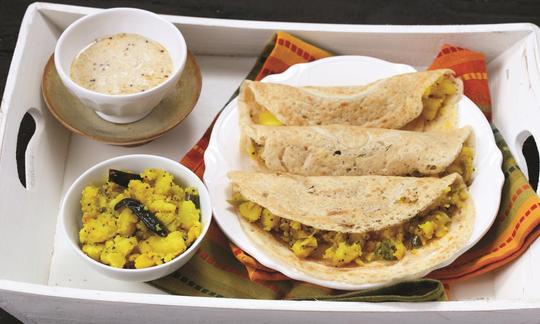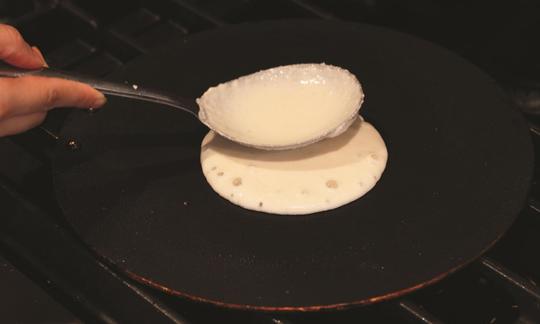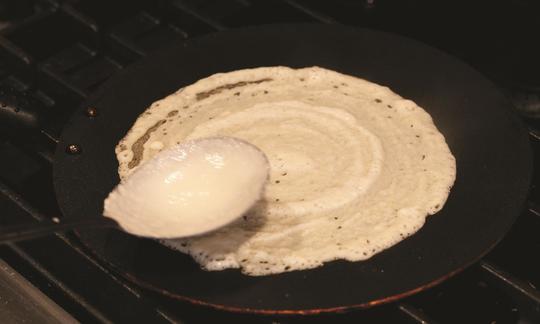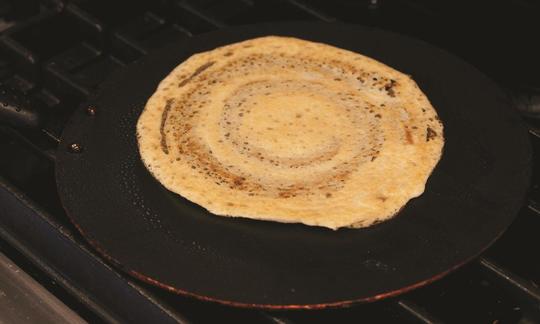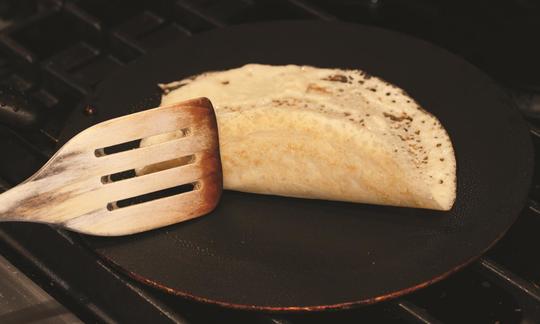30-Minute Rice Dosas
vegan
Ingredients (for servings, )
| For the dosa crepes | |
|---|---|
| 4 ¾ oz | Oat flakes (raw?, organic?) |
| ¼ tsp | Fenugreek seeds, raw?, organic? (Methi = fenugreek) (0.03 oz) |
| 6 ½ oz | Rice flour, white, (gluten-free, raw, organic?) |
| ¾ tsp | Salt, table salt (0.16 oz) |
| 440 ml | Drinking water, raw (organic?) (15 oz) |
| ⅞ oz | Ginger, raw (organic?) |
| 1 | Chili peppers, green (raw, organic?) (1.6 oz) |
| ¾ tsp | Baker's yeast (active dry yeast, organic?) (0.11 oz) |
| 1 tsp | Baking powder (baking agent, organic?, vegan?) (0.11 oz) |
Equipment
- blender or shredder
- skillet (frying pan)
- stove
Type of preparation
- cook
- fry
- chop or grind
- blend
- meld
- purée
Preparation
For the dosa crepes
Combine the rolled oats and fenugreek seed in a blender and blend to a fine powder.The original recipe states that you have the option to use either rolled oats or oat flour. Alternatively, you can use 70 g rolled oats and 70 g urad dal flour.
Add the rice flour, salt, water, ginger, and chili pepper to the blender and blend well to make a smooth batter. Blend for three 1-minute cycles to incorporate well, scraping down the sides in-between if necessary.
The author uses a hot green chili pepper. If you don’t like spicy dishes, you should remove the seeds. You can also use ¼ tsp cayenne pepper instead.
Add the yeast and baking powder and blend for 30 seconds. Pour the batter into a bowl and let rest for 30 minutes.
Cooking the crepes
Heat a large skillet over medium heat. When hot, drizzle a few drops of oil into the skillet and spread using a paper towel. Drop ¼ to ⅓ cup of the batter in the skillet. Use a ladle to spread it from the center of the pan out, in circles. Cook until the crepe starts to come off the edges, about 2 minutes. Flip and cook for another 30 seconds to a minute. Transfer the cooked crepe to a container lined with paper towels and repeat with the remaining batter.The crepes can be stored at room temperature for the day, or refrigerated for up to 4 days. Reheat before serving.
|
Nutritional Information per person
Convert per 100g
|
2000 kcal | |
|---|---|---|
| Energy | 208 kcal | 10.4% |
| Fat/Lipids | 2.0 g | 2.9% |
| Saturated Fats | 0.39 g | 2.0% |
| Carbohydrates (inc.dietary fiber) | 42 g | 15.5% |
| Sugars | 0.73 g | 0.8% |
| Fiber | 3.5 g | 13.8% |
| Protein/Albumin | 5.3 g | 10.7% |
| Cooking Salt (Na:355.5 mg) | 903 mg | 37.6% |
| Essential micronutrients with the highest proportions | per person | 2000 kcal | |
|---|---|---|---|
| Min | Manganese, Mn | 1.2 mg | 62.0% |
| Sodium, Na | 355 mg | 44.0% | |
| Prot | Tryptophan (Trp, W) | 0.07 g | 28.0% |
| Elem | Phosphorus, P | 176 mg | 25.0% |
| Vit | Vitamin C (ascorbic acid) | 18 mg | 23.0% |
| Min | Selenium, Se | 11 µg | 21.0% |
| Vit | Thiamine (vitamin B1) | 0.21 mg | 19.0% |
| Prot | Threonine (Thr, T) | 0.17 g | 18.0% |
| Prot | Valine (Val, V) | 0.29 g | 18.0% |
| Min | Copper, Cu | 0.16 mg | 17.0% |
Detailed Nutritional Information per Person for this Recipe
The majority of the nutritional information comes from the USDA (US Department of Agriculture). This means that the information for natural products is often incomplete or only given within broader categories, whereas in most cases products made from these have more complete information displayed.
If we take flaxseed, for example, the important essential amino acid ALA (omega-3) is only included in an overarching category whereas for flaxseed oil ALA is listed specifically. In time, we will be able to change this, but it will require a lot of work. An “i” appears behind ingredients that have been adjusted and an explanation appears when you hover over this symbol.
For Erb Muesli, the original calculations resulted in 48 % of the daily requirement of ALA — but with the correction, we see that the muesli actually covers >100 % of the necessary recommendation for the omega-3 fatty acid ALA. Our goal is to eventually be able to compare the nutritional value of our recipes with those that are used in conventional western lifestyles.
| Essential fatty acids | per person | 2000 kcal |
|---|---|---|
| Linoleic acid; LA; 18:2 omega-6 | 0.62 g | 6.0% |
| Alpha-Linolenic acid; ALA; 18:3 omega-3 | 0.04 g | 2.0% |
| Essential amino acids | per person | 2000 kcal |
|---|---|---|
| Tryptophan (Trp, W) | 0.07 g | 28.0% |
| Threonine (Thr, T) | 0.17 g | 18.0% |
| Valine (Val, V) | 0.29 g | 18.0% |
| Isoleucine (Ile, I) | 0.21 g | 17.0% |
| Leucine (Leu, L) | 0.41 g | 17.0% |
| Phenylalanine (Phe, F) | 0.27 g | 17.0% |
| Lysine (Lys, K) | 0.24 g | 13.0% |
| Methionine (Met, M) | 0.10 g | 11.0% |
| Vitamins | per person | 2000 kcal |
|---|---|---|
| Vitamin C (ascorbic acid) | 18 mg | 23.0% |
| Thiamine (vitamin B1) | 0.21 mg | 19.0% |
| Vitamin B6 (pyridoxine) | 0.19 mg | 14.0% |
| Folate, as the active form of folic acid (née vitamin B9 and | 23 µg | 11.0% |
| Pantothenic acid (vitamin B5) | 0.59 mg | 10.0% |
| Biotin (ex vitamin B7, H) | 4.7 µg | 9.0% |
| Niacin (née vitamin B3) | 1.4 mg | 8.0% |
| Riboflavin (vitamin B2) | 0.07 mg | 5.0% |
| Vitamin E, as a-TEs | 0.19 mg | 2.0% |
| Vitamin K | 1.5 µg | 2.0% |
| Vitamin A, as RAE | 4.4 µg | 1.0% |
| Essential macroelements (macronutrients) | per person | 2000 kcal |
|---|---|---|
| Sodium, Na | 355 mg | 44.0% |
| Phosphorus, P | 176 mg | 25.0% |
| Magnesium, Mg | 48 mg | 13.0% |
| Potassium, K | 158 mg | 8.0% |
| Calcium, Ca | 26 mg | 3.0% |
| Essential trace elements (micronutrients) | per person | 2000 kcal |
|---|---|---|
| Manganese, Mn | 1.2 mg | 62.0% |
| Selenium, Se | 11 µg | 21.0% |
| Copper, Cu | 0.16 mg | 17.0% |
| Zinc, Zn | 1.2 mg | 12.0% |
| Iron, Fe | 1.3 mg | 9.0% |
| Fluorine, F | 52 µg | 1.0% |
| Iod, I (Jod, J) | 0.41 µg | < 0.1% |
This quick version of dosa crepes calls for oat flour and rice flour. You can serve the crepes with coconut chutney or a potato side dish.
Number of dosas: According to the author, this recipe to serve six makes between 10 and 12 rice dosas.
Dosas: Dosas are a type of hearty crepe from India that are traditionally cooked on a cast-iron griddle. The original recipe is for a fermented batter made of rice and urad beans. In India, dosas are usually eaten for breakfast, typically together with sambhar (a sauce with a lentil base), masala potatoes or another potato side dish, and a coconut chutney.
Fenugreek seed: Fenugreek seed is a typical Indian spice and is also often an ingredient in curry powder. It is also used in South Tyrol, where it is added to bread and cheese. Fenugreek seed has a strong aroma and is reminiscent of freshly cut hay. The flavor is slightly bitter and the texture somewhat mealy. The flavor develops best when the seeds are cooked or toasted. Fenugreek seeds are also used to treat coughs and help clear the respiratory tract. For additional information, please see the ingredient description for fenugreek seed.
Making your own rice flour: It is essentially quite easy to make rice flour and all you need is a high-speed blender and a package of rice (either white or brown).
You should adjust the amount of rice you use to the maximum volume of the blender, but then make sure not to fill the blender completely so that the flour is of high quality. Then you simply blend until the desired flour consistency is achieved. The finer the flour is, the better it will work as an ingredient for baked goods or binder since it will change the texture less. Stored in an air-tight container, the rice flour will keep at least a year. However, if you use brown rice the flour can only be stored for about half a year, even under the best of storage conditions.
Simple filling method: Use the spatula to lift the dosas up a bit on two sides so that they take on the form of a taco and then fill.
Urad beans: Urad beans, also called white and black lentils, are a popular type of beans in India. As they have the same cooking time as rice, it works well to serve these beans along with rice. In addition to the dried beans, you can also use the fresh pods and bean sprouts.
Fermentation: Alternatively, you can make the dosas in the traditional way with fermentation. The cookbook Vegan Richa’s Indian Cuisine includes a recipe like this on page 204 called South Indian Lentil and Rice Dosas.

